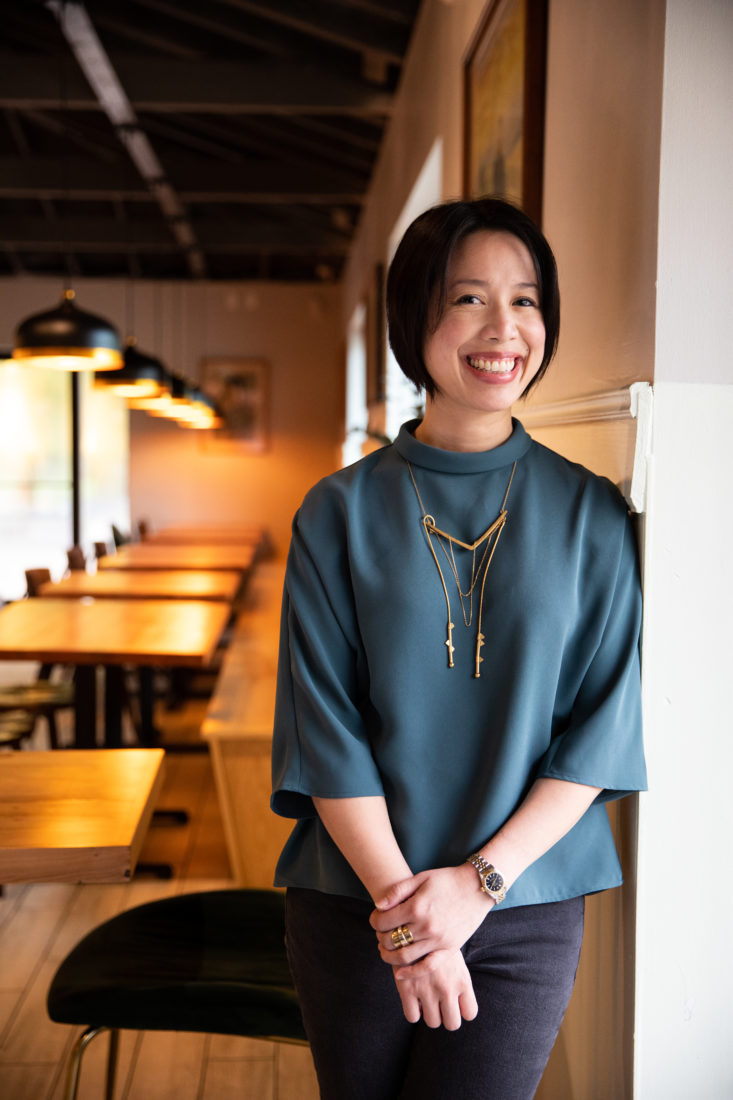My crab legs at Xin Chào come as a pair. Cracked by the kitchen, battered and deep-fried, the long, thin shells bulge with sweet coral flesh. Painted with a sticky mix of tamarind pulp, palm sugar, and fish sauce, they eat messy like barbecue ribs. I snack on them as a bar appetizer, popping shards of crust in my mouth, digging into crevices with a small fork to snag big hunks of crab.
About the time I finish my legs, a young couple get theirs. They ooh and aah and selfie tamarind-smeared faces. They drink margaritas, sweetened with house-pressed sugarcane juice and garnished with cilantro. And I try not to stare as an idea comes into focus: Crossed one atop the other, crowned with red chiles, these crab legs define a
twenty-first-century coat of arms, a herald for polyglot Houston.
“This is a second-generation restaurant,” Christine Ha says when I call to talk about Xin Chào, open since September of last year. Ha and co-chef Tony Nguyen both grew up in Houston, eating with their Vietnamese immigrant parents in first-generation restaurants in the suburbs, like Thiên Thanh, beloved for stuffed rice noodle rolls known as bánh cuô´n. They also developed appetites for Cajun crawfish and Hill Country brisket, Tex-Mex enchiladas and Czech-Tex kolaches. At Xin Chào the chefs interpret their shared ancestry and the flavors of their Houston childhoods to forge a modern Southern restaurant.
“What we call pizza in Houston is not what Italians call pizza back in Naples,” Ha says when I ask about how her crab legs came to be. “Pizza began there, but that’s not where it is now.” Foods brought here by immigrants change over generations. Back in Ho Chi Minh City, street vendors wok-fry crabs from local waters and drench them in tamarind sauce. At Xin Chào, Ha and Nguyen playfully buck the traditions of Vietnam and the Gulf South, shipping in kings worthy of their name from Alaska. And they fry those oversize legs in oversize baskets that look like they were borrowed from Popeyes. Make a joke about everything being bigger in Texas. I’ll be at Xin Chào, gnawing those legs, licking tamarind sauce from my fingertips.
Set on a corner parcel in the Sixth Ward on the western edge of downtown, Xin Chào is fronted by a gravel patio ringed with picnic tables and umbrellas. Inside, white lights wrap the rafters of what used to be a barbecue joint. Paintings of rural Vietnam, collected over a lifetime by Ha’s architect father, line the walls. A mural by the Houston artist Caroline Truong bounces into view by the front door. If Keith Haring had focused on flowers instead of bodies, he would have painted something like this.
Twenty-somethings lounge on green velvet slipper chairs and plywood banquettes. They stir drinks with lemongrass shoots. They stand on the rungs of blue velvet bar stools to take Instagram shots of egg rolls served with carrot-floated nuoc cham, alabaster congee bobbed with ivory mushrooms, and see-through dumplings stuffed with smoked beef cheek. Above the bar television, where an episode of Cupcake Wars plays on mute, a regiment of white ceramic lucky cat statuettes stands at attention, paws frozen in midsalute. Below, a frozen drink machine churns with rosé spritzers.

Ha won fame in 2012 as a contestant on the television show MasterChef, on which she became known as the Blind Chef because of a neurological condition. Talk to her now about reality show fame and she sounds slightly embarrassed. “That status brings people in the door and helps build the buzz,” she tells me. “But we still have to cook great food.”
A different buzz got me in the door. A friend had texted a picture of the menu and pointed out the Nguyen-er Nguyen-er Chicken Dinner!, a dish of lemongrass-buttermilk-marinated chicken, fried in a rice-and-flour batter, served with spiced honey and something called sidewinder fries. I loved the playfulness, wrapped in a pronunciation lesson.
When I visit, that fried chicken is a Thursday special, so I miss it on my weekend trip. But I do get a chance to try those sidewinder fries, which Nguyen and Ha serve as an appetizer with a thimble of aioli. Imagine curly fries that have gained girth and integrity. Dunked in that aioli, which Ha and Nguyen blend with beef tallow, they prove an ideal prequel to my favorite entree, a massive beef rib bone, stripped bare, jutting over the rim of a deep ceramic plate. Hunks of smoke-tinged meat blanket flat rice noodles. Some noodles are crisp, some chewy, and some are soaked with a murky broth that looks and tastes like pho. As the mound dwindles, I switch from a Bellaire Boulevardier, a bitter rye-based cocktail, to a Kabinett riesling from August Kesseler that cuts through that fatty and luscious beef.
I have an irrational bias against bread pudding. When I see it on the menu, I think, Here’s a chef trying to sell me stale bread as a delicacy. This square of pudding, dense and velvety, redeems the form. Topped with a scoop of vanilla ice cream, it arrives on a skid of dulce de leche. When I turn my head to look at the side of that square, I see layers of shaved coconut and what used to be baguettes. When I turn to look into the faces of the beautiful young women and men at neighboring tables, I see the future of the South, smiling bright.








